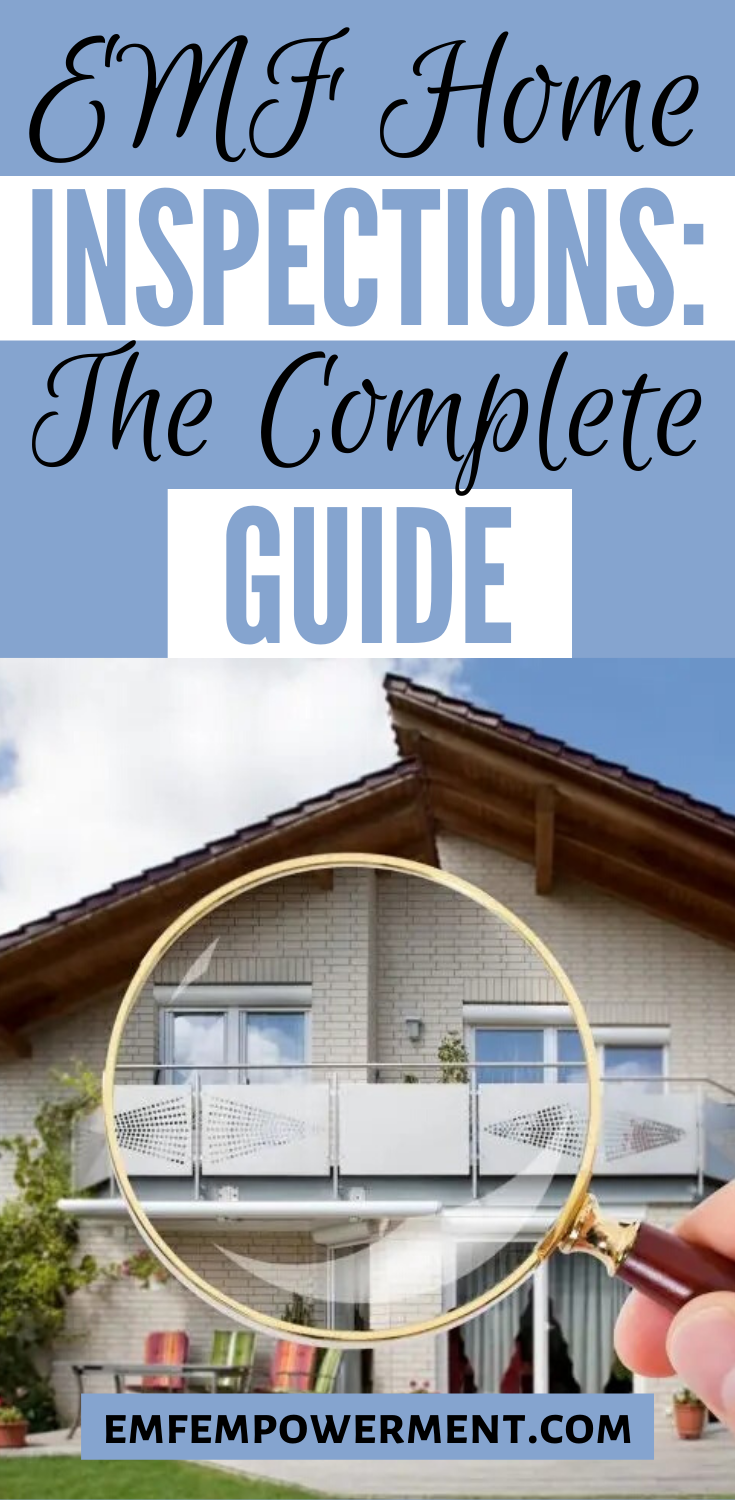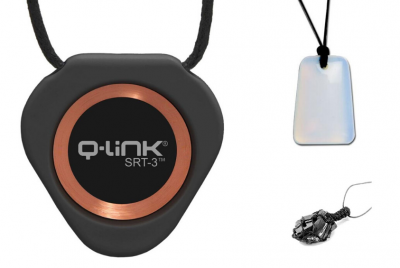When worn correctly, both Bluetooth and wired earbuds offer a lightweight and comfortable way to listen…
EMF Home Inspections: Your Complete Guide
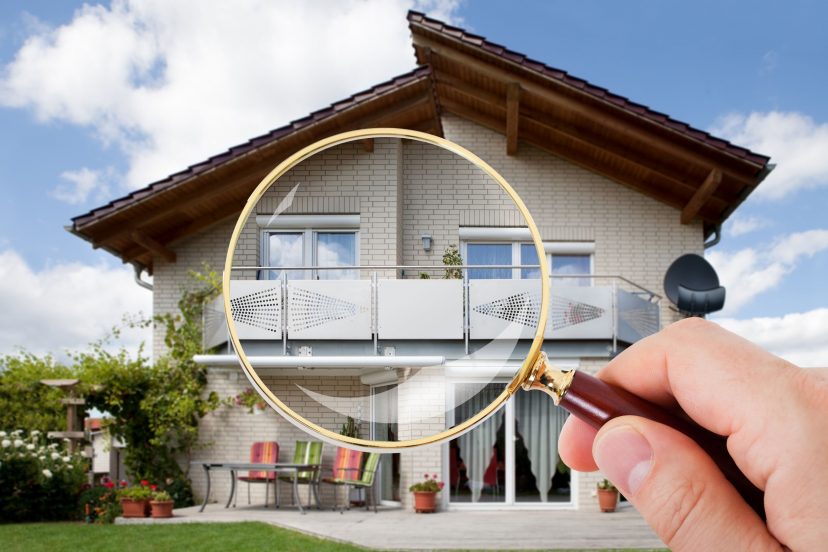
*We may earn a commission for purchases made using our links. Please see our disclosure to learn more.
How much EMF are you exposed at home? What can you do to cut down on that amount?
These are the questions that a lot of visitors to this site have, and they are also questions that an EMF inspector seeks to answer. If you’re unsure of what to do next when it comes to protecting yourself and your family, you may want to contact a qualified EMF inspector. Just as a doctor is trained to spot and fix health problems, a qualified EMF inspector is trained to identify and reduce EMF radiation in the home.
What is an EMF inspection?
An EMF inspection is done by a qualified EMF inspector. They comb over your home from top to bottom, determining what steps you can really take to lower your home’s EMF levels. They will often measure levels of EMF radiation and dirty electricity present in the home, look at what devices your family uses and how they use them, and inspect how nearby antennas, WiFi signals, smart meters, and other sources of radiation may be impacting your home.
Since the bedroom is considered a key area due to the amount of time we spend there and the importance of sleep, many inspectors will also spend a great deal of time focusing on those rooms in particular. It may seem like they are ignoring other rooms, but this is not really the case. The goal of an inspector is to reduce your home’s levels and try to confine the bulk of the EMF radiation that remains to lower-traffic areas.
How does an inspector become qualified?
This is a tricky question because there is not a government body that regulates and licenses EMF inspectors. There are, however, private organizations such as EMF-Experts that will provide education and certification to instructors. Knowing someone completed a course may provide some peace of mind.
That being said, the best way for an inspector to become qualified is simply years in the field. Qualified inspectors may have a background in electromagnetic field testing, engineering, building biology, electromagnetic radiation, or other related areas. One organization, the Institute of Building Biology, offers certifications including Electromagnetic Radiation Specialist.
According to the Building Biology website, the Electromagnetic Radiation Specialist program requires an inspector to complete 200 units, and the program covers ways to assess and eliminate EMF and EMR in homes, offices, schools, and other commercial buildings. These inspectors are also qualified to advise architects and designers on ways to cut down on EMF radiation in new constructions.
Reasons to hire a professional
It is possible to test your home’s EMF levels yourself. In fact, we frequently recommend doing so on this site. You may wonder if there’s still a reason to hire a professional if you can check your levels yourself.
The fact is, many people eventually reach the point where they aren’t sure what else to do to lower their home’s EMF levels, short of going off-grid or creating a complete dead-zone using EMF paint. Those are not realistic options for the average person. Doing it yourself may save money, but it will also leave you blind to some potential solutions that could work for your home. Being able to do some of the work yourself doesn’t negate the value of the inspection.
An inspector is beneficial because they can pinpoint things that you may not have noticed, or known about. Once you’ve gone as far as you can on your own, an inspector can help reduce your exposure even further. They will often give you advice that is tailored to your specific homes and the devices you and your family use, which can be extremely enlightening and incredibly useful.
Additionally, many inspectors are geared towards teaching you how to safely co-exist with technology. If you’re tempted to create a total dead zone in your house but don’t want to give up modern conveniences and energy-efficient appliances, an inspector can teach you how to use these things while being exposed to minimal amounts of EMF radiation. Sometimes even just switching up the design of your home can have a huge impact.
Another reason to hire a professional is that they have access to professional-grade equipment, which is generally much more sensitive than a consumer-grade EMF meter. This means an inspector may be able to pick up on EMF radiation that your meter cannot. Even if your meter indicates your home’s levels are within a safe range, it’s still not a bad idea to confirm with an inspector.
An EMF home inspector may also come in handy if you are building your own home. As we mentioned earlier, inspectors who are qualified through the Building Biology Institute can communicate with builders to create lower-EMF homes. Design tricks, such as placing smart meters against a wall in a non-high traffic area, can allow you to co-exist with technology while still lowering your EMF levels.
Finally, EMF home inspectors are also useful in real estate transactions. If you are in the market for a new home and you’re opting to purchase one that is pre-built, an inspector can take a look at the house prior to purchase. This may be helpful because things such as proximity to power lines and cell towers really can’t be changed later on. If EMF radiation is a concern for you, you may not want to purchase a home directly under a high voltage power line, for example. An inspector can help point out some of these things, allowing you to make the best decision possible for your family.
EMF Home Inspection Pre-Checklist
There is quite a bit you can do on your own to lower your home’s EMF levels. Basic things such as switching to wired internet if you currently use WiFi will reduce your overall exposure a great deal. These are things that can be done without the aid of an inspector, and it’s a good idea to take care of them prior to your home inspection, in order to maximize the value. You want your inspection to reveal things you didn’t know you could do to lower your home’s levels — not the basics.
- As we already mentioned, going wired and turning off WiFi is one of the biggest things you can do to lower your home’s EMF levels. WiFi signals produce a great deal of radiation, and they do this constantly.
- If going wired isn’t an option for you, install a WiFi router guard, and shut your modem off at night when not in use. This will at least keep your home’s levels lower during nighttime.
- Swap out your LED and CFL bulbs for incandescents. They may be more energy-efficient, but these bulbs produce dirty electricity.
- Install a dirty electricity filter on each circuit in your home. You can also purchase a dirty electricity monitor to track the amount of dirty electricity in every room.
- If you live in a city that uses smart meters, install a smart meter cover. To protect the interior of your home, paint the walls nearest the meter with an EMF shielding paint.
- Reduce your exposure in the bedroom by using an EMF bed canopy.
- If your family uses a landline, switch to either a corded or low-EMF cordless phone. Typical cordless phones produce significant amounts of EMF radiation as the receiver and the base station communicate.
- Use fewer smart appliances, as they generally produce RF-EMF radiation. Energy-efficient appliances also generate more dirty electricity.
- If you have little ones, consider using lower-EMF baby monitors, if you choose to use one at all.
- For those out there who use cell phones, purchase and install an RF-shielding case. This will cut down on the amount of radiation produced by the phone. If you have several cell phone users in your home, putting cases on all of them can really cut down on your home’s EMF levels.
What to expect during an inspection
During an inspection, the inspector will likely go through each room of your home, measuring the levels of dirty electricity, electric field radiation, magnetic field radiation, and radiofrequency radiation. They may use tools such as an oscilloscope, a professional-grade EMF meter, and a spectrum analyzer. These tools are often too expensive for the average consumer, but they are quite effective at finding the four types of EMF radiation.
An EMF home inspection is not limited to the interior of your home, either. Often times an inspector will take note of surrounding sources of EMF radiation, such as cell towers, power lines, and neighboring WiFi signals, as well. This is important because these things contribute significantly to your home’s overall EMF levels, and yet their presence is usually beyond your control. A home inspection will help shed light on what steps you can take to reduce their effect on your home’s levels.
After the inspector has thoroughly combed through the interior and exterior of your home, they will usually take some time to speak with you about their findings. Depending on the inspector used, many will prepare a report for you on exactly what sources of radiation are present in your home, along with recommended steps to reduce your exposure. The inspector’s report is usually a highly useful and eye-opening analysis of the inspector’s findings, and it’s really the primary reason to hire an inspector. The report should provide concrete information you can act on to lower your home’s levels.
Finding an inspector
If you’re interested in an EMF home inspection, the first step is to find a qualified EMF inspector near you. For this example, we’ll pretend we’re looking for an EMF inspector near New Orleans, Lousiana.
First, we’ll navigate our web browser over to the Google search page. From there, we can type in “EMF home inspections New Orleans”. You can simply replace “New Orleans” with your city’s name for results near you.
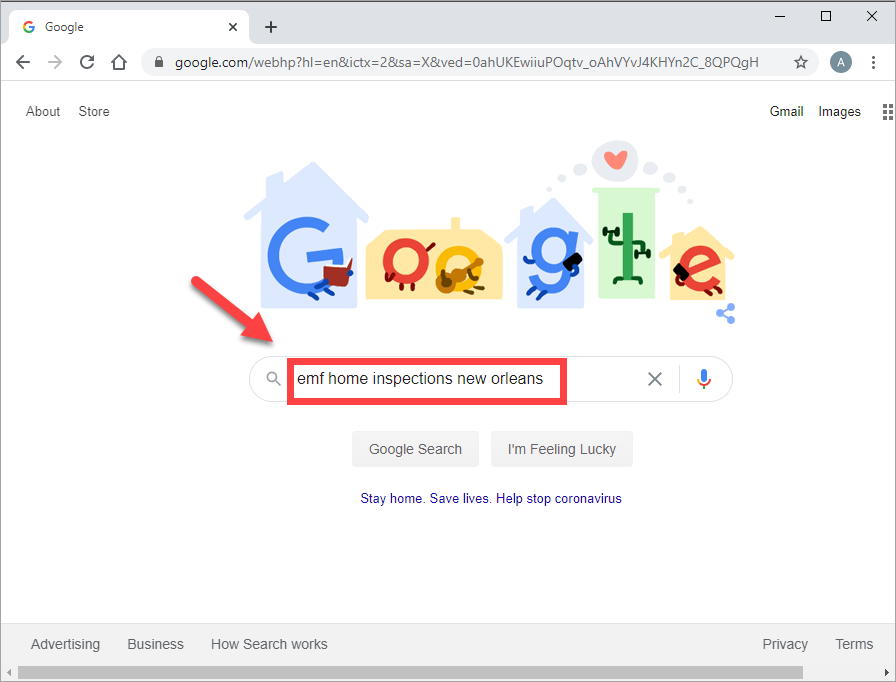
When searching for New Orleans EMF inspectors, several pages of results are found — but not all of them are particularly useful.
We need to sift through the results to find actual, qualified EMF inspectors in the area. The first couple of results in Google are for home inspectors that make no mention of EMF radiation on their websites. That means they may or may not be educated in EMF radiation, and they may or may not have the necessary equipment to check for it. One option is to call and speak with the inspector directly.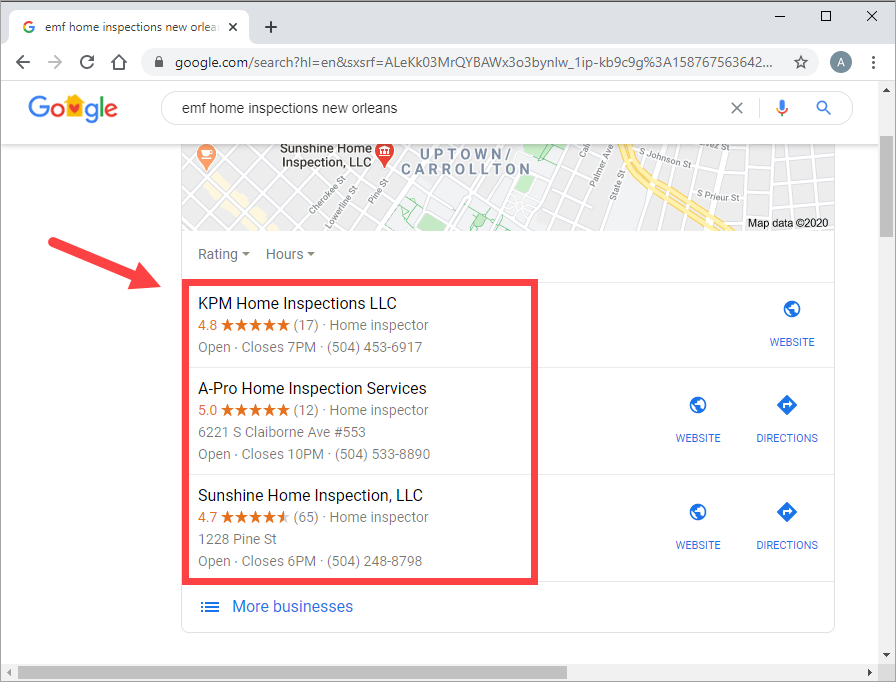
Continuing to browse through the search results, we find a Texas-based company called ScanTech Technical Consulting that claims to do indoor EMI testing.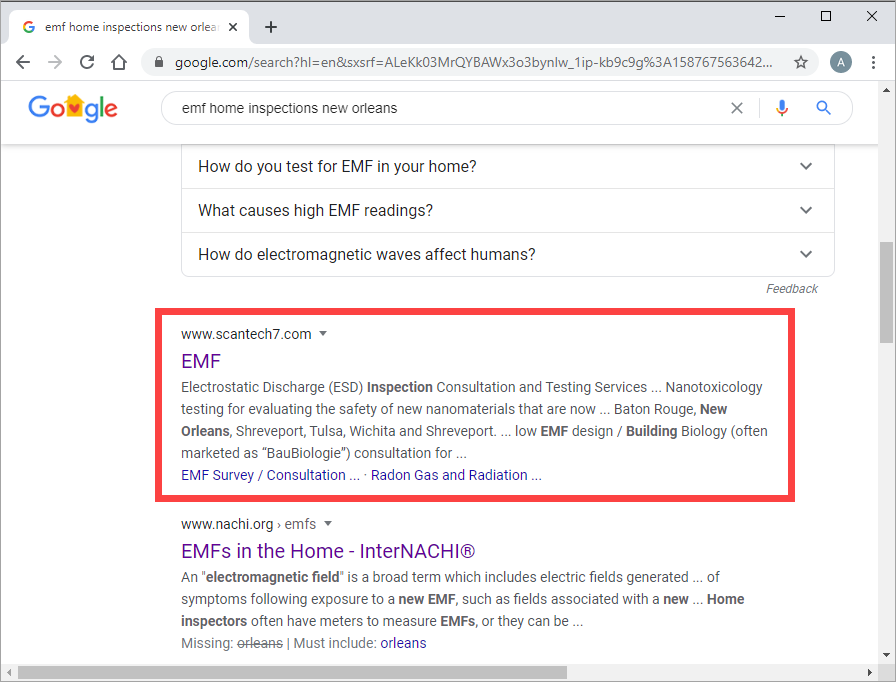
While this initially seems promising, further reading of the website reveals that they only work with commercial clients.
In fact, it appears there may not be a dedicated EMF consultant in the area — so does that mean you’re out of luck?
Not necessarily. Many inspectors will work with non-local clients, even traveling to do inspections. Michigan EMF Specialists, for example, will work with you remotely to try and lower your home’s EMF levels. According to their website, they are able to do this by recommending specific meters to use. Those readings are then processed by the inspector’s professional-grade equipment, revealing more information than would have been available through the meter alone. This may even be cheaper than an in-person inspection as you are just paying for a consultant fee and the meter.
Another resource for EMF home inspections is the Building Biology Institute. This is the same institute that offers EMR certifications to inspectors, and they maintain a list of certified inspectors on their website. This list is not necessarily comprehensive — it only includes those inspectors that are paying to maintain their presence — but it’s a useful way to find qualified inspectors in an area without combing Google search results.
Parting Words
There is a lot you can do on your own to reduce your EMF radiation levels at home. That being said, there is also a lot that a professional may help shed light on. EMF home inspections are worthwhile because they often reveal things you couldn’t have found using consumer-grade equipment. Once you’ve gone as far as you can on your own, consider bringing an inspector in. The results may just surprise you. 